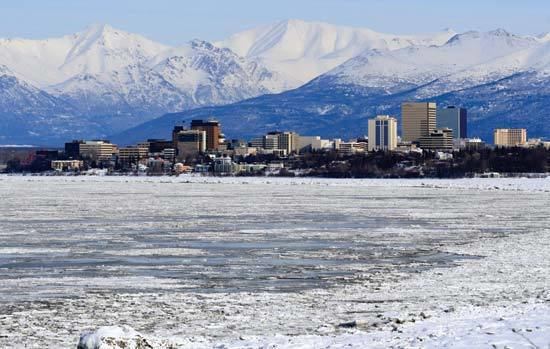Length 300 mi (480 km) E-W Area 50,447 km² Country United States of America Passes Turnagain Pass | Elevation 4,016 m | |
 | ||
Mountains | ||
The Chugach Mountains of southern Alaska are the northernmost of the several mountain ranges that make up the Pacific Coast Ranges of the western edge of North America. The range is about 250 miles (402 km) long and 60 miles (97 km) wide, and extends from the Knik and Turnagain Arms of the Cook Inlet on the west to Bering Glacier, Tana Glacier, and the Tana River on the east. It is bounded on the north by the Matanuska, Copper, and Chitina rivers. The highest point of the Chugach Mountains is Mount Marcus Baker, at 13,094 feet (3,991 m), but with an average elevation of 4,006 feet (1,221 m), most of its summits are not especially high. Even so its position along the Gulf of Alaska ensures more snowfall in the Chugach than anywhere else in the world; an annual average of over 1500 cm (600 in).
Contents
Map of Chugach Mountains, Alaska 99686, USA
The mountains are protected in the Chugach State Park and the Chugach National Forest. Near to Anchorage, they are a popular destination for outdoor activities. Weather permitting, the World Extreme Skiing Championship is held annually in the Chugach Mountains near Valdez.
The Richardson Highway, Seward Highway, Portage Glacier Highway, and the Glenn Highway run through the Chugach Mountains. The Anton Anderson Memorial Tunnel of the Portage Glacier Highway provides railroad and automobile access underneath Maynard Mountain between Portage Lake and the city of Whittier on Prince William Sound.
History
The name "Chugach" comes from Chugach Sugpiaq "Cuungaaciiq" (in the modern spelling) meaning "Cook Inlet"; Russians applied this name to the indigenous Sugpiaq or Alutiiq people of the southern Kenai Peninsula and Prince William Sound, usually describing place names as Chugachik and the people as Chugatz and Tshougatskoy. In 1898 United States Army Captain William R. Abercrombie spelled the name "Chugatch" and applied it to the mountains. It is possible that the Koniagmiut (Sugpiat or Alutiit of the Kodiak Archipelago and the Alaska Peninsula) may also have called these northern Sugpiat "Cuungaaciirmiut" in ancient times but it is also possible that this was a neologism during Russian times.
Mountains
The twelve highest peaks in the Chugach Mountains are listed below:
Other important peaks in the Chugach Mountains include:
